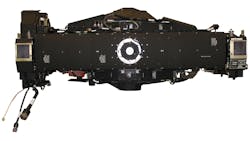Collins Aerospace Systems has received a $19.9 million contract from the U.S. Navy’s Office of Naval Research (ONR) to experiment on the company’s MS-177A long-range, multispectral imaging sensor while flying on a P-3C Orion aircraft. It will be the first time that the MS-177A will be flown by the U.S. Navy. An earlier version of the long-range imaging sensor, the MS-177, completed flight testing on board a U.S. Air Force (USAF) Global Hawk aircraft and will soon go operational because of those tests.
According to the 30-month contract, Collins Aerospace, a unit of Raytheon Technologies Corp., will assemble an MS-177A sensor from its existing MS-177 production line and flight test hardware and install the sensor and test equipment onboard the P-3C aircraft. The P-3C will perform experimental flights in a maritime threat environment to better understand the capability of the MS-177A long-range imaging sensor to expand the Navy’s maritime intelligence, surveillance, and reconnaissance (ISR) capabilities in anti-submarine-warfare (ASW), anti-surface-warfare (ASuW), and mine-warfare (MIW) fighting domains. Results of the experiment will demonstrate the MS-177A’s ability to expand the Navy’s maritime ISR capabilities in the Anti-Submarine Warfare (ASW), Anti-Surface Warfare (ASuW) and Mine Warfare (MIW) mission domains using a mature USAF sensor system.
“When used in conjunction with other spectrum sensors, our proven MS-177 family of systems can greatly increase the probability of detection for threats, while operating in both permissive and contested environments,” said Kevin Raftery, vice-president and general manager, ISR and Space Solutions for Collins Aerospace (Cedar Rapids, IA). The MS-177A system enables high geolocation accuracy, collecting images in the visible, near-infrared (near-IR), short-wave IR, and microwave-IR regions. It provides a wide field of view (FoV) with high spectral and spatial resolution to enable enhanced ISR capabilities at greater distances, even when operating in contested environments, at land sea, and in the air.
About the Author
Jack Browne
Technical Contributor
Jack Browne, Technical Contributor, has worked in technical publishing for over 30 years. He managed the content and production of three technical journals while at the American Institute of Physics, including Medical Physics and the Journal of Vacuum Science & Technology. He has been a Publisher and Editor for Penton Media, started the firm’s Wireless Symposium & Exhibition trade show in 1993, and currently serves as Technical Contributor for that company's Microwaves & RF magazine. Browne, who holds a BS in Mathematics from City College of New York and BA degrees in English and Philosophy from Fordham University, is a member of the IEEE.
